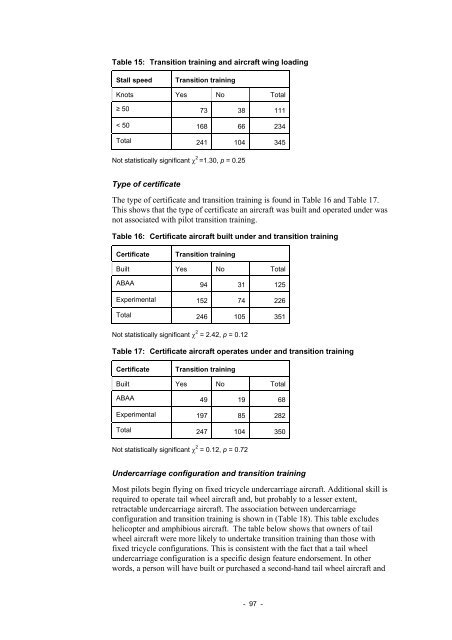Amateur-built and experimental aircraft - Australian Transport Safety ...
Amateur-built and experimental aircraft - Australian Transport Safety ...
Amateur-built and experimental aircraft - Australian Transport Safety ...
Create successful ePaper yourself
Turn your PDF publications into a flip-book with our unique Google optimized e-Paper software.
Table 15: Transition training <strong>and</strong> <strong>aircraft</strong> wing loading<br />
Stall speed Transition training<br />
Knots Yes No Total<br />
≥ 50 73 38 111<br />
< 50 168 66 234<br />
Total 241 104 345<br />
Not statistically significant χ 2 =1.30, p = 0.25<br />
Type of certificate<br />
The type of certificate <strong>and</strong> transition training is found in Table 16 <strong>and</strong> Table 17.<br />
This shows that the type of certificate an <strong>aircraft</strong> was <strong>built</strong> <strong>and</strong> operated under was<br />
not associated with pilot transition training.<br />
Table 16: Certificate <strong>aircraft</strong> <strong>built</strong> under <strong>and</strong> transition training<br />
Certificate Transition training<br />
Built Yes No Total<br />
ABAA 94 31 125<br />
Experimental 152 74 226<br />
Total 246 105 351<br />
Not statistically significant χ 2 = 2.42, p = 0.12<br />
Table 17: Certificate <strong>aircraft</strong> operates under <strong>and</strong> transition training<br />
Certificate Transition training<br />
Built Yes No Total<br />
ABAA 49 19 68<br />
Experimental 197 85 282<br />
Total 247 104 350<br />
Not statistically significant χ 2 = 0.12, p = 0.72<br />
Undercarriage configuration <strong>and</strong> transition training<br />
Most pilots begin flying on fixed tricycle undercarriage <strong>aircraft</strong>. Additional skill is<br />
required to operate tail wheel <strong>aircraft</strong> <strong>and</strong>, but probably to a lesser extent,<br />
retractable undercarriage <strong>aircraft</strong>. The association between undercarriage<br />
configuration <strong>and</strong> transition training is shown in (Table 18). This table excludes<br />
helicopter <strong>and</strong> amphibious <strong>aircraft</strong>. The table below shows that owners of tail<br />
wheel <strong>aircraft</strong> were more likely to undertake transition training than those with<br />
fixed tricycle configurations. This is consistent with the fact that a tail wheel<br />
undercarriage configuration is a specific design feature endorsement. In other<br />
words, a person will have <strong>built</strong> or purchased a second-h<strong>and</strong> tail wheel <strong>aircraft</strong> <strong>and</strong><br />
- 97 -

















